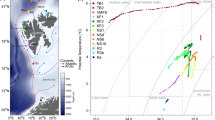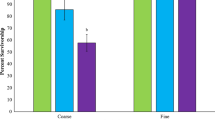Abstract
Distribution, abundance and age of diapause eggs from three species of calanoid copepods (in particular from Acartia spp. most likely Acartia tonsa, and Centropages hamatus and less numerous from Temora longicornis) were recorded in sediment profiles by enumerating hatched nauplii from incubated sediment samples. Phytoplankton pigments and 210Pb and 137Cs analyses indicated that the sedimentation regimes were different between two southern and two northern stations of the island Funen, Denmark. Significant variations in vertical distribution, abundance and mortality of diapause eggs were found between the stations. Dating of the sediment cores suggested a ~70-year maximum age of viable eggs on the northernmost stations, and ~28 year at the southernmost stations. The eggs exhibited a significantly higher mortality rate at the southernmost stations compared with the northernmost, 0.35–0.53 year−1 vs. 0.07–0.08 year−1 with no systematic pattern among species. The differences in abundance, mortality and age of the diapause eggs are suggested to be due to the sediment characteristics in which they are buried.





Similar content being viewed by others
References
Appleby PG (2001) Chronostratigraphic techniques in recent sediments. In: Last WM, Smol JP (eds) Tracking environmental change using lake sediments. Volume 1: basin analysis, coring and chronological techniques. Kluwer Academic Publishers, Dordrecht, pp 171–203
Ban S (1992) Effects of photoperiod, temperature, and population density on induction of diapause egg production in Eurytemora affinis (Copepoda: Calanoida) in Lake Ohnuma, Hokkaido, Japan. J Crust Biol 12:361–367
Ban S, Minoda T (1994) Introduction of diapause egg production in Eurytemora affinis by their own metabolites. Hydrobiologia 292(293):185–189
Bianchi TS, Johansson B, Elmgren R (2000) Breakdown of phytoplankton pigments in Baltic sediments: effects of anoxia and loss of deposit-feeding macro fauna. J Exp Mar Biol Ecol 251:161–183
Chen F, Marcus NH (1997) Subitaneous, diapause, and delayed hatching eggs of planktonic copepods from the northern Gulf of Mexico: morphology and hatching success. Mar Biol 127:587–597
Dahl K, Josefson AB (2009) Marine områder 2007. NOVANA, Tilstand og udvikling i miljø- og naturkvaliteten. Danmarks Miljøundersøgelser, Aarhus Universitet. 113 s.—Faglig rapport fra DMU nr. 707 [in Danish]. http://www.dmu.dk/Pub/FR707.pdf
Dahms H-U (1995) Dormancy in the Copepoda—an overview. Hydrobiologia 306:199–211
Dahms H-U, Li X, Zhang G, Qian PY (2006) Resting stages of Tortanus forcipatus (Crustacea, Calanoida) in sediments of Victoria Harbor (Hong Kong). Estuar Coast Shelf Sci 67:562–568
Danks HV (1987) Insect dormancy: an ecological perspective. Biological survey of Canada. Tyrell Press, Gloucester, p 439
De Stasio BT Jr (1989) The seed bank of a freshwater crustacean: copepodology for the plant ecologist. Ecology 70:1377–1389
Drillet G, Iversen MH, Sørensen TF, Ramløv H, Lund T, Hansen BW (2006) Effect of cold storage upon eggs of a calanoid copepod, Acartia tonsa (Dana) and their offspring. Aquaculture 254:714–729
Engel M, Hirche H-J (2004) Seasonal variability and inter-specific differences in hatching of calanoid copepod resting eggs from sediments of the German Bight (North Sea). J Plank Res 26:1083–1093
Grice GD, Marcus NH (1981) Dormant eggs of marine copepods. Oceanogr Mar Biol Annu Rev 19:125–140
Guerrero F, Rodriguez V (1998) Existence and significance of Acartia grani resting eggs (Copepoda: Calanoida) in sediments of a coastal station in the Alboran Sea (SE Spain). J Plank Res 20:305–314
Hairston NG Jr, Cáceres CE (1996) Distribution of crustacean diapause: micro- and macroevolutionary pattern and process. Hydrobiologia 320:27–44
Hairston NG Jr, De Stasio BT (1988) Rate of the evolution slowed by a dormant propagule pool. Nature 336:239–242
Hairston NG Jr, Van Brunt RA, Kearns CM, Engstrom DR (1995) Age and survivorship of diapausing eggs in a sediment egg bank. Ecology 76:1706–1711
Hall CJ, Burns CW (2001) Hatching of Boeckella hamata (Copepoda: Calanoida) resting eggs from sediments of a tidally influenced lake. New Zealand J Mar Freshw Res 35:235–238
Hansen JLS, Bendtsen J (2006) Klimabetingede effekter på marine økosystemer. Danmarks Miljøundersøgelser, Aarhus Universitet. 50s.—Faglig rapport fra DMU nr. 598 [in Danish]. http://www.dmu.dk/Pub/FR598.pdf
Hansen JLS, Josefson AB (2003) Accumulation of algal pigments and live planktonic diatoms in aphotic sediments during the spring bloom in the transition zone of the North and Baltic Seas. Mar Biol Prog Ser 248:41–54
Hansen JLS, Manscher O (2008) Iltsvind i de danske farvande i August–September 2008, Danmarks Miljøundersøgelser, Aarhus Universitet. 19s. [in Danish]. http://www.dmu.dk/fileadmin/Resources/DMU/Vand/Iltsvind/2008aug/DMU_Iltrapport_Aug_2008.pdf
Invidia M, Sei S, Gorbi G (2004) Survival of the copepod Acartia tonsa following egg exposure to near anoxia and to sulfide at different pH values. Mar Ecol Prog Ser 276:187–196
IPCC (2007) 4th assessment report, climate change 2007
Jiang X, Wang G, Li S (2004) Age, distribution and abundance of viable resting eggs of Acartia pacifica (Copepoda: Calanoida) in Xiamen Bay, China. J Exp Mar Biol Ecol 312:89–100
Josefson AB, Hansen JLS (2003) Quantifying plant pigments and live diatoms in aphotic sediments of Scandinavian coastal waters confirms a major route in the pelagic-benthic coupling. Mar Biol 142:649–658
Kanneworff E, Nicolaisen W (1973) The HAPS. A frame supported bottom corer. Ophelia 10:119–129
Kasahara S, Uye S (1979) Calanoid copepod eggs in sea-bottom muds. V. Seasonal changes in hatching of subitaneous and diapause eggs of Tortanus forcipatus. Mar Biol 55:63–68
Kasahara S, Uye S, Onbe T (1975a) Calanoid copepod eggs in sea-bottom muds. II. Seasonal cycles of abundance in the populations of several species of copepods and their eggs in the Inland Sea of Japan. Mar Biol 31:25–29
Kasahara S, Onbe T, Kamigaki M (1975b) Calanoid copepod eggs in sea-bottom muds. III. Effects of temperature, salinity and other factors on the hatching of resting eggs of Tortanus forcipatus. Mar Bio 31:31–35
Katajisto T (1996) Copepod eggs survive a decade in the sediments of the Baltic Sea. Hydrobiologia 320:153–159
Kiørboe T, Nielsen TG (1994) Regulation of zooplankton biomass and production in a temperate, coastal ecosystem. 1. Copepods. Limnol Oceanogr 39:493–507
Lindley JA (1990) Distribution of overwintering calanoid copepod eggs in sea-bed sediments around southern Britain. Mar Biol 104:209–217
Madhupratap M, Nehring S, Lenz J (1996) Resting eggs of zooplankton (Copepoda and Cladocera) from the Kiel Bay and adjacent waters (southwestern Baltic). Mar Biol 125:77–87
Marcus NH (1980) Photoperiodic control of diapause in the marine calanoid copepod Labidocera aestiva. Biol Bull 159:311–318
Marcus NH (1982) Photoperiodic and temperature regulation of diapause in Labidocera aestiva (Copepoda: Calanoida). Biol Bull 162:45–52
Marcus NH (1989) Abundance in bottom sediments and hatching requirements of eggs of Centropages hamatus (Copepoda: Calanoida) from the Alligator Harbor region, Florida. Biol Bull 176:142–146
Marcus NH (1996) Ecological and evolutionary significance of resting eggs in marine copepods: past, present and future studies. Hydrobiologia 320:141–152
Marcus NH, Boero F (1998) The importance of benthic-pelagic coupling and the forgotten role of life cycles in coastal aquatic systems. Limnol Oceanogr 43:763–768
Marcus NH, Fuller CM (1986) Subitaneous and diapause eggs of Labidocera aestiva Wheeler (Copepoda: Calanoida): differences in fall velocity and density. J Exp Mar Biol Ecol 99:247–256
Marcus NH, Lutz RV (1994) Effects of anoxia on the viability of subitaneous eggs of planktonic copepods. Mar Biol 121:83–87
Marcus NH, Murray M (2001) Copepod diapause eggs: a potential source of nauplii for aquaculture. Aquaculture 201:107–115
Marcus NH, Lutz RV, Burnett W, Cable P (1994) Age, viability, and vertical distribution of zooplankton resting eggs from an anoxic basin: evidence of an egg bank. Limnol Oceanogr 39:154–158
Marcus NH, Lutz RV, Chanton JP (1997) Impact of anoxia and sulphide on the viability of eggs of three planktonic copepods. Mar Ecol Prog Ser 146:291–295
Nielsen P, Mortensen J, Vismann B, Hansen BW (2006) Physiological tolerance of marine calanoid copepod eggs to sulfide. Mar Ecol Prog Ser 328:171–182
Onbé T (1978) Sugar flotation method for sorting the resting eggs of marine cladocerans and copepods from sea-bottom sediment. Bull Japan Soc Sci Fish 44:1411
Sazhina LI (1968) On hibernation of eggs of marine Calanoida. Zool Zh 47:1554–1557 (Russian with English abstract)
Smetacek VS (1985) Role of sinking in diatom life-history cycles: ecological, evolutionary and geological significance. Mar Biol 84:239–251
Sokal RR, Rohlf FJ (1995) Biometry. The principles and practice of statistics in biological research, 3rd edn. WH Freeman and Co, New York, p 887
Sullivan BK, McManus LT (1986) Factors controlling seasonal succession of the copepods Acartia hudsonica and A. tonsa in Narragansett Bay, Rhode Island: temperature and resting egg production. Mar Ecol Prog Ser 28:121–128
Uye S-I (1985) Resting egg production as a life history strategy of marine planktonic copepods. Bull Mar Sci 37:440–449
Wang G, Jiang X, Wu L, Shaojing L (2005) Differences in the density, sinking rate and biochemical composition of Centropages tenuiremis (Copepoda: Calanoida) subitaneous and diapause eggs. Mar Ecol Prog Ser 288:165–171
Wentworth CK (1922) A scale of grade and class terms for clastic sediments. Jour Geol 30:377–392
Zervoudaki S, Nielsen TG, Carstensen J (2009) Seasonal succession and composition of the zooplankton community along an eutrophication and salinity gradient exemplified by Danish waters. J Plankton Res 31:1475–1492
Zhang X, Long Y, He X, Fu J, Zhang Y (2006) A simplified 137Cs transport model for estimating erosion rates in undisturbed soil. J Environ Radioact 99:1242–1246
Zillioux EJ, Gonzales G (1972) Egg dormancy in a neritic calanoid copepod and its implications to overwintering in boreal waters. Archo Oceanogr Limnol 5:217–230
Acknowledgments
We thank M. H. Jensen, Environment Centre Odense for practical help and for data. We are grateful to A. B. Faarborg for technical help in the laboratory. We thank B. L. Møller for HPLC-measurements of pigment and the crew at R/V Liv II for assistance in the field. We also wish to thank the anonymous reviewers for their very valuable comments on the manuscript. The project was supported by the Danish National Science Research Council (grant no.272-07-0485) to Dr B. W. H.
Author information
Authors and Affiliations
Corresponding author
Additional information
Communicated by U. Sommer.
Rights and permissions
About this article
Cite this article
Sichlau, M.H., Hansen, J.L.S., Andersen, T.J. et al. Distribution and mortality of diapause eggs from calanoid copepods in relation to sedimentation regimes. Mar Biol 158, 665–676 (2011). https://doi.org/10.1007/s00227-010-1590-6
Received:
Accepted:
Published:
Issue Date:
DOI: https://doi.org/10.1007/s00227-010-1590-6




